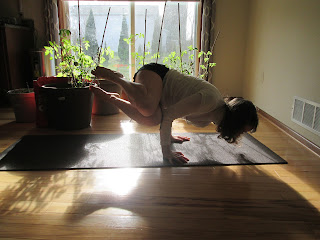Adding Yoga to group CBT for depression and anxiety improved outcome (study)
Evidence
supports the use of Cognitive Behavioral Therapy (CBT) as treatment for anxiety
and depression (1). Cognitive Behavioral Therapy uses strategies to address unhelpful thoughts and patterns of behavior to enable mechanisms
that help to make a shift in the conditions that trigger and exacerbate
symptoms of depression and anxiety.
Even though CBT is considered an effective
therapy, fifty percent of adults who complete CBT continue to have symptoms (2).
Therefore, adding strategies to augment the effectiveness of CBT is a path that
warrants attention and research.
Incorporating mindfulness into CBT has shown promising
results. Yoga is an ancient practice that integrates mindfulness and physical
exercise through the combination of breathing, gentle movements and physical
postures. Research has shown that yoga as a mind-body discipline has multiple
benefits on health and wellbeing (3). Also, small studies have indicated that
the practice of yoga may be beneficial to relieve symptoms of depression and
anxiety (4). However, no previous study
was done to compare the benefits of the use of CBT with and without yoga, so
the study done by Melissa O’Shea and colleagues in Australia is the first
one.
The study was published in 2022 by the Journal
of Affective Disorders (5). The purpose of the research was to compare the
effects of using CBT in one group of clients with the combination of CBT plus
yoga in another group. The study was designed to answer the question on whether
adding yoga would help to augment the effects of CBT to treat anxiety and depression
To answer this question the primary outcome
was measured through the use of the Depression Anxiety Stress Scale-21
(DASS-21). This score includes three subscales that measure the intensity of
depression, anxiety and stress. The DASS-21 was measured in both groups at
baseline, after completing treatment and three months post-treatment.
A total of 59 participants were recruited. Seventy-one
percent of the participants were women. 27 participants belonged to the CBT
group (Control group), and 32 participants completed the CBT plus Yoga
treatment (Intervention group).
The control group only received the CBT group
program, which was delivered weekly for two hours during the eight-week period.
The program provided support through the use of strategies to understand the
symptoms, practical management, and it also “encouraged practice within and
outside the group to maintain skills and prevent relapse.”
The intervention group had the Therapeutic
Yoga Program added to the delivery of CBT. This Yoga program involved weekly
group sessions that lasted sixty minutes, as well as a personalized home
practice that was developed to suit each person’s limitations, considering
safety and motivations. The home practice had to be performed at least three
times a week for 15 to 30 minutes. A practice log had to be documented weekly
by the participant.
The yoga practice combined relaxation,
breathing, gentle physical postures and movements suitable for all levels of
experience.
Both
groups responded well to the therapies. Both the control and the intervention
group had their scores reduced, but the CBT plus Yoga group showed
significantly lower DASS total scores and depressive symptoms compared to the
CBT alone after treatment and three months post-treatment. The intervention
group also had fewer anxiety and stress symptoms after the treatment.
The results
of the study suggest that yoga may be considered as an added therapy to CBT to
enhance the beneficial effects of CBT and to accomplish sustainable
improvements of depression and anxiety.
Participants
that included yoga as part of their management of depression and anxiety
reported feeling more receptive to their CBT therapy. They reported
feeling more empowered to respond to the therapy; they also expressed they had better levels of
energy and better quality of sleep.
The promising results of this study with a limited
number of participants indicates the need to research this field further.
Adding yoga as an adjunct of therapy may be a cost-effective strategy with multiple
potential benefits. This study suggests that adding yoga to CBT can improve the
outcome.
References:
1) 1) Carpenter,
J.K., Andrews, L.A., Witcraft, S.M., Powers, M.B., Smits, J.A.J., Hofmann, S.
G., 2018. Cognitive behavioral therapy for anxiety and related disorders: a
metaanalysis of randomized placebo-controlled trials. Depress. Anxiety 35 (6),
502–514. https://doi.org/10.1002/da.22728.
2) 2) Santoft,
F., Axelsson, E., Ost, L.G., Hedman-Lagerlof, M., Fust, J., Hedman-Lagerlof,
E., 2019.
Cognitive behaviour therapy for depression
in primary care: systematic review and meta-analysis. Psychol. Med. 49 (8),
1266–1274. https://doi.org/10.1017/ S0033291718004208.
3) 3) https://formative.jmir.org/2022/5/e37876/
4) 4) Khalsa, M.K., Greiner-Ferris, J.M., Hofmann,
S.G., Khalsa, S.B.S., 2015. Yoga-enhanced cognitive behavioural therapy (Y-CBT)
for anxiety management: a pilot study. Clin. Psychol. Psychother. 22 (4),
364–371. https://doi.org/10.1002/cpp.1902.
5) 5) O’Sheall, M., Capon, H., Skvare, D.,
Evans, S., McIvry, S., Harris, J., Houston, E., Berk, M.,2022. A pragmatic preference
trial of therapeutic yoga as an adjunct to group cognitive behavioral therapy
versus group CBT alone for depression and anxiety: a pilot study. Journal of
Affective Disorders 307 (2022) 1-10



